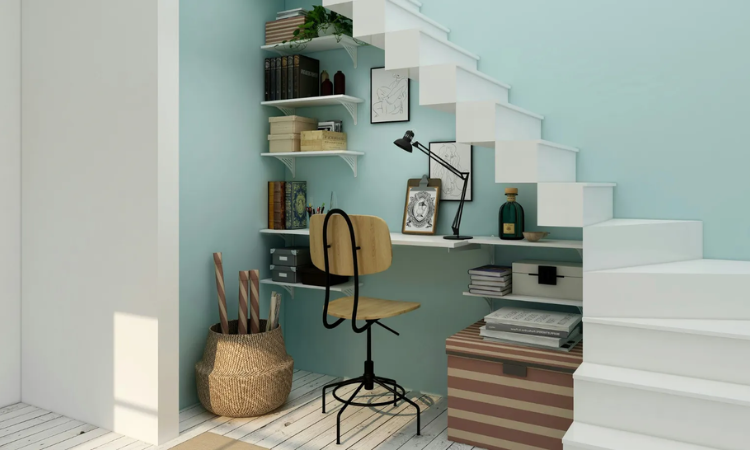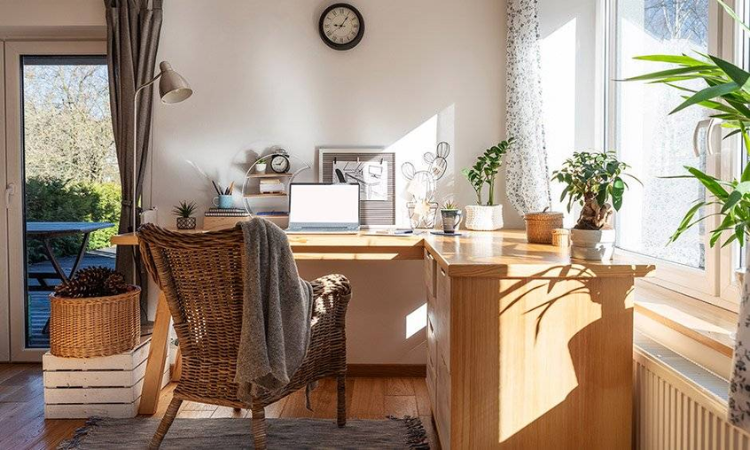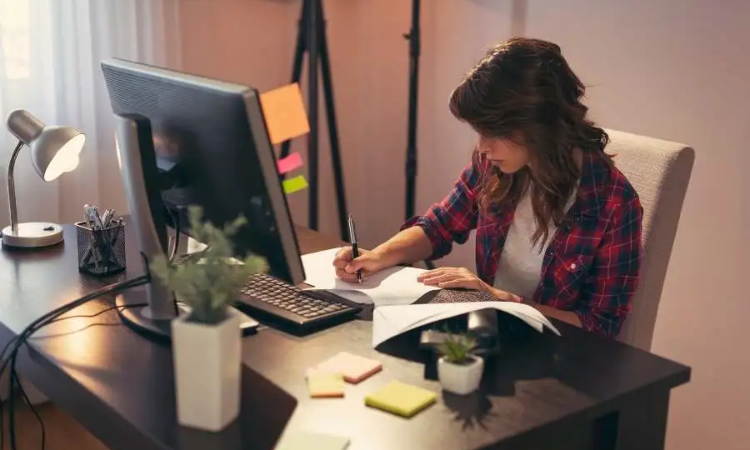As an interior designer with over a decade of experience helping clients create functional and inspiring work-from-home spaces, I’ve learned some key best practices. Whether you’re carving out a home office in your apartment or dedicating an entire room to remote work, interior design can make a huge impact.
In this article, I’ll share my top tips and real-world examples of optimizing interior design for remote jobs, based on extensive first-hand experience.
Lighting Sets the Tone
Lighting is one of the most crucial elements in designing a productive work-from-home environment. The right lighting setup can help increase focus, boost mood, reduce eyestrain, and improve video call appearance.
I always recommend installing overhead lighting that provides bright, white light. A central ceiling fixture with at least 3000-4000 lumens works well for most home offices. Increase the wattage if you have a larger room.
Supplement overhead light with desk and task lamps. Gooseneck lamps are incredibly versatile for directing light precisely where you need it. I often use swing arm lamps on work surfaces, as they’re easily adjustable.
Finally, make sure to bring in natural light whenever possible. Studies consistently show exposure to sunlight improves productivity and overall well-being. I install skylights or specific desks placed near windows for nearly all my work-from-home design projects.
Choose Multifunctional Furniture
To make the most of often limited space in home offices, I specify furniture that serves multiple purposes.
For example, I recently designed a small home office for a client using an expandable table that could widen to hold more materials or narrow to a slimmer profile when not in use. I paired it with a rolling 3-drawer cart for additional storage that could be tucked neatly under the table when closed.
Other excellent multifunctional furniture choices include:
- Desks with built-in storage cubbies, shelves, and file drawers
- Modular wall units and bookcases to hold work materials
- Nesting tables that slide together when not in use
- Coffee tables that flip up to become a standing desk
Invest in Ergonomic Seating

The average remote employee spends 6-8 hours per day sitting at their workstation. An ergonomic chair designed for long periods of seated work is non-negotiable.
In my 10 years as a designer, I’ve specified hundreds of task chairs. Key features to look for include adjustable seat height, lumbar support, adjustable arm width, and tilt tension controls. The breathable mesh fabric also helps minimize heat buildup compared to faux or real leather upholstery.
I always stress investing in the highest-quality chair possible within budget constraints. A well-engineered ergonomic chair that keeps you pain-free will easily pay for itself over years of consistent daily use. Brands like Herman Miller, Steelcase, and Haworth consistently rise to the top in independent testing.
Zone for Productivity
When working from home, it can be difficult to mentally “switch gears” between job tasks and personal time. I help clients delineate work and living spaces through intentional interior design zoning.
For home offices incorporated into living areas or bedrooms, I define the work zone using area rugs in office-appropriate textures and patterns. I also design custom room dividers and screens that cordon off the workspace visually while allowing light and air circulation.
In dedicated home office rooms, I zone the entire area for work functions only. This helps cue the brain that it’s time to work whenever entering that room. Removing entertainment seating like plush armchairs in favor of task seating has a similar effect.
Embrace Sound-Masking Strategies

Managing noise can be one of the top challenges when working from home. Whether it’s neighbors, roommates, traffic, construction, or other ambient sounds, excessive noise hinders productivity and erodes focus.
There are two main approaches I use to help clients overcome distracting noise in home offices. First, contain sound within the room by installing thick rugs, curtains, and even acoustic wall and ceiling panels. Sound-absorbing fixtures prevent noises from intruding and bouncing around.
I also recommend incorporating pleasant background noise to mask unwanted sounds. White noise machines are excellent for blocking irregular outside noise. For a more natural effect, I’ll design an indoor water feature like a tabletop fountain that provides soothing ambient noise.
Display Inspiring Accents
Much of interior design centers on elevating and improving moods through aesthetically pleasing surroundings. I help clients infuse their home office with artwork, greenery, and objects that ignite their passions.
When selecting accents, I focus on positive cues that relate to the client’s work, hobbies, or aspirations. For a budding entrepreneur, I’ll display art and books featuring their favorite business leaders. For a graphic designer, I’ll incorporate colorful artwork in their preferred styles.
Accents that reflect positive emotions, like family photos, vacation souvenirs, or images of natural serenity can also boost mood while working from home. I see interior design choices that put smiles on clients’ faces whenever they’re working as absolute wins.
Create Space to Recharge
While optimizing focus and productivity often centers interior design decisions for home offices, I also ensure clients have space to recharge. Prolonged periods of intense mental exertion lead to fatigue that hampers work quality.
In larger dedicated office rooms, I incorporate a small lounge area with a comfortable chair or loveseat. This provides a spot to relax during breaks without leaving the workspace.
For more compact layouts, I ensure the room connects easily to living areas where clients can fully decompress. A dining room table works nicely for spreading out materials during an intense work session, and then transitioning to casual family time over a shared meal.
Final Thoughts
Approaching work-from-home interior design with intentionality regarding layout, furniture selections, storage, lighting, and aesthetics pays off. People are often surprised by how professional and motivating their home office feels after even modest upgrades guided by best practices.
As remote and hybrid arrangements show no signs of slowing down, the value of expert interior design focused on improving daily experience, productivity, and well-being within home workspaces continues rising exponentially. I remain committed to helping clients create home offices where they can thrive personally and professionally.
Also Read – Designing a Stylish and Functional Home Gym for 2024

Kumar Tomar is a distinguished writer at DesignHomes.in, specializing in home design and interior decor. Holding a degree in Interior Design from the National Institute of Design, Kumar combines formal education with practical experience to deliver insightful and authoritative content. With over 8 years in the industry, he is known for his in-depth knowledge of design trends and his ability to provide actionable advice for homeowners. Kumar’s expertise and dedication to high-quality writing make him a trusted resource for those seeking to enhance their living spaces. Follow Kumar on Instagram for the latest design inspiration and tips.
